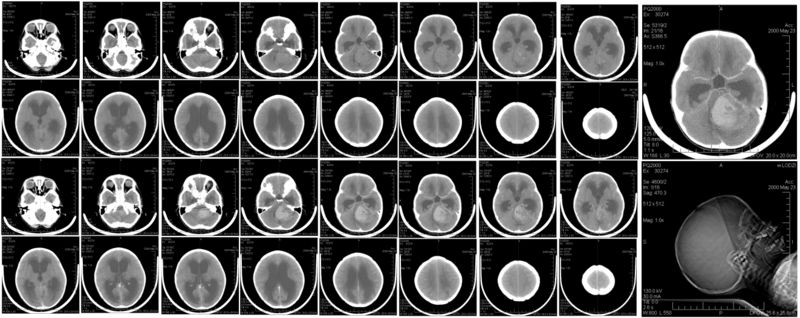Medulloblastoma CT: Difference between revisions
Jump to navigation
Jump to search
No edit summary |
No edit summary |
||
| Line 4: | Line 4: | ||
==Overview== | ==Overview== | ||
On head CT scan, medulloblastoma is characterized by a hyperdense mass arising from the cerebellar vermis with prominent contrast enhancement and effacement of the fourth ventricle.<ref name="radio">Medulloblastoma. Radiopaedia(2015) http://radiopaedia.org/articles/medulloblastoma Accessed on September, 30th 2015</ref> | |||
==CT== | ==CT== | ||
*On head CT scan, medulloblastoma is characterized by:<ref name="radio">Medulloblastoma. Radiopaedia(2015) http://radiopaedia.org/articles/medulloblastoma Accessed on September, 30th 2015</ref> | |||
:* A hyperdense mass arising from the cerebellar vermis | |||
:* Effacement of the fourth ventricle and basal cisterns | |||
:* Dilated ventricles due to obstructive hydrocephalus | |||
:* Cysts formation and necrosis are observed among 40-50% of cases | |||
:* Calcification is observed among 10-20% of cases | |||
[[Image:CompT.jpg|thumb|left|1200px|CT scan, showing a tumorous mass in the [[posterior fossa]], giving rise to obstructive [[hydrocephalus]], in a six year old girl]] | [[Image:CompT.jpg|thumb|left|1200px|CT scan, showing a tumorous mass in the [[posterior fossa]], giving rise to obstructive [[hydrocephalus]], in a six year old girl]] | ||
<br clear="left"/> | <br clear="left"/> | ||
Revision as of 11:50, 1 October 2015
|
Medulloblastoma Microchapters |
|
Diagnosis |
|---|
|
Treatment |
|
Case studies |
|
Medulloblastoma CT On the Web |
|
American Roentgen Ray Society Images of Medulloblastoma CT |
Editor-In-Chief: C. Michael Gibson, M.S., M.D. [1] Associate Editor(s)-in-Chief: Haytham Allaham, M.D. [2]
Overview
On head CT scan, medulloblastoma is characterized by a hyperdense mass arising from the cerebellar vermis with prominent contrast enhancement and effacement of the fourth ventricle.[1]
CT
- On head CT scan, medulloblastoma is characterized by:[1]
- A hyperdense mass arising from the cerebellar vermis
- Effacement of the fourth ventricle and basal cisterns
- Dilated ventricles due to obstructive hydrocephalus
- Cysts formation and necrosis are observed among 40-50% of cases
- Calcification is observed among 10-20% of cases

References
- ↑ 1.0 1.1 Medulloblastoma. Radiopaedia(2015) http://radiopaedia.org/articles/medulloblastoma Accessed on September, 30th 2015